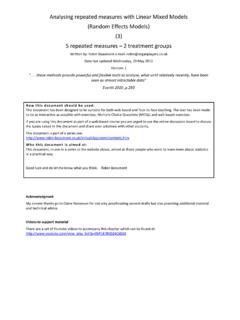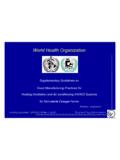Transcription of Introduction to health Informatics Types of Health ...
1 Introduction to Health Informatics Types of Health information Systems Types of Health information Systems (IS). By Robin Beaumont e-mail: Thursday, 08 September 2011. Contents 1. Introduction .. 2. 2. What is an information system (IS).. 2. 3. Subject and Task based systems .. 3. 4. Operational/tactical and strategic Health information Systems .. 4. 5. Clinical and Administrative Health information Systems .. 5. 6. The Electronic Health /Patient Record (EHR / EPR) .. 6. 7. Financial and Clinical Health information Systems .. 7. 8. Decision Support Systems (DSS) .. 7. 9. Robotics and Simulators .. 8. 10. Telemedicine, Telematics and eHealth Systems .. 9. 11. Computer Simulations .. 9. 12. 13. 13. References .. 13. 14.
2 Links - largely provided by students .. 14. Robin Beaumont 08/09/2011 D:\web_sites_mine\HIcourseweb new\chap12\s2\ Page 1. Introduction to Health Informatics Types of Health information Systems 1. Introduction This document introduces the Types of Health information systems that are around and how various people have tried to classify such systems from a number of perspectives. 2. What is an information system (IS). Although an information system may not involve a computer (the traditional filing cabinet is a good example of one such IS) in this document we will assume that IS means a computerised information system . While the systems view of the world will be introduced elsewhere ( Introduction to Modelling chapter) I have repeated the introductory information below.
3 Those who accept the systems view believe that everything can be described by considering: Input(s). Process(es). Output(s). Boundary A system receives data - inputs which is then possibly processed in some way before producing some type of output. The human body is possibly the most beautiful and complex system there is. The processing aspect also contains, memory and monitoring functions. In Informatics the idea of a system is often applied to a wide range of things. For example the hospital, the nurse bank and the mortuary are all systems. Each of these systems has a clearly defined boundary. For example, we know that the local shoe shop is not part of the hospital system . The two diagrams below provide both a template and an example of a typical system .
4 [Please note that they are incomplete]. From the above diagrams it appears that there is a great deal to consider for any system . Depending upon your viewpoint you may focus on either the input, processes or output. It is often felt that certain models of systems consider in too greater depth the input aspects to the detriment of other aspects such as the processes and more importantly the output. Because of this, 'output based' specifications have become popular where the model Robin Beaumont 08/09/2011 D:\web_sites_mine\HIcourseweb new\chap12\s2\ Page 2. Introduction to Health Informatics Types of Health information Systems concentrates on describing the present or required outputs. Taking the above example of an appointment system , an output based specification would focus on the reports required rather than the processes and input required to produce them, at least initially.
5 3. Subject and Task based systems James Martin, as long ago as 1981, suggested that you could divide information systems into those that are either 'subject' or 'task' based, although he did not use these exact terms. He defined a 'subject' based system to be one which related to a particular thing in the organisation such as a patient or doctor. In contrast a task based system was one that supported a particular task. Examples of task based systems would be standalone operating theatre or admissions/ discharge systems. He suggested that 'subject' rather than 'task' based systems were best ( -31). The reason for his preference is that it reduces data duplication. In a task based system if a subject often undergoes many tasks, basic details ( name and address) would be collected each time, in contrast in a subject oriented system basic information would be collected once and would flow from task to task.
6 Considering the above dichotomy one can see how the Electronic Health /Patient Record (EHR/EPR) is an example of a 'subject' based system . Exercise 1. In you area of work what type of information systems exist, subject or task based. Do you agree with the assertion that subject systems are best? Also consider your answer from both security and risk management perspectives. Produce a list below, possibly in some form of table Robin Beaumont 08/09/2011 D:\web_sites_mine\HIcourseweb new\chap12\s2\ Page 3. Introduction to Health Informatics Types of Health information Systems 4. Operational/tactical and strategic Health information Systems One of the most common ways to classify information is to use the operational, tactical, strategic divisions discussed in the section on information and knowledge (Chapter 5 section 3 at ).
7 At each level of the information pyramid there are also information systems which deal specifically with that type of information . The information system Pyramid Strategic information systems=. DSSs and EISs Type '3'. strategic information Type '2' Management Tactical information information systems=. MISs, report generators Operational Type '3' information Operational information systems=. Admin (PAS). Payroll. Clinical AbouZahr C, Adjei S, Kanchanachitra C, 2007 From data to policy: good EPR. practices and cautionary tales Lancet 369: 1039 46. Recently AbouZahr, Adjei & Kanchanachitra 2007 in a fascinating article, have updated the pyramid (right above) to take into account global information , along with the process of data collection to policy formulation.
8 The pyramid classification has several advantages: It allows assessment of how far down the road of computerisation an organisation is. This can be done because operational systems are usually developed before MISs (Management information Systems) or EISs (executive information Systems). It allows the highlighting of any uneven or inappropriate systems development. This is by considering the hierarchical data dependency, management information systems requiring an operational system to feed them. By considering the dependencies illustrated on the left hand side one can identify deficiencies in individual systems as given on the right hand side. Examples of using this approach are given below. Nurse Requires external Regional management data?
9 Simulation model systems DSSs pretty pictures in the sky Has no Has no EISs Requires ?MISs? Clinical nursing reports system Requires system MISs integration? Reports Case mix system Invoicing system (no ownership +. statistical validity). Requires Has no Has no Operational databases invoicing, data Adequate real time Activity DB. data (clinical collecting (clinical). systems). 1. The former Northern Regional HA (UK) developed a computerised planning tool (a simulation) which provided output information concerning possible future hospital requirements by projecting hospital capacities and waiting list information . However this did not have the necessary feeder systems to keep it up to date. Robin Beaumont 08/09/2011 D:\web_sites_mine\HIcourseweb new\chap12\s2\ Page 4.
10 Introduction to Health Informatics Types of Health information Systems 2. All hospitals have problems working out costings which had to be done by top down apportioning as there are no feeder systems providing data on actual usage per client. In contrast American hospitals frequently use item billing systems. 3. Several hospitals have nurse management systems the data for which is gathered manually by collecting a plethora of data on paper, much of which could be obtained from a clinical system directly. These are but a few local UK examples and are no where near the worst to be found. Exercise 2. Can you think of any systems where you work were there is a mismatch between the operational feeder system and a tactical/ strategic information system ?


















